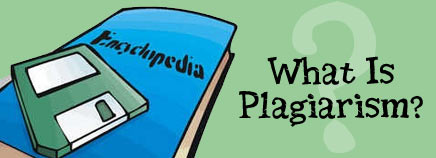Plagiarism
You probably know what plagiarism is—claiming someone else’s work as your own. This is most often used in reference to written words, but may be extended to other media as well. From a legal standpoint, plagiarism per se is not illegal, although it is widely considered unethical. However, if the plagiarism also involves copyright infringement, then this would be a violation of the law. Certainly, in the context of your role as a student, especially as a student in the Honors College, plagiarism is almost universally regarded as academic dishonesty, and subject to punitive actions as described in the University Student Handbook.
In most of term paper assignments, the following examples of plagiarism are always given.
Consider the first paragraph of the section “Stress” on the textbook of “Engineering Materials: Properties and Selection (8th Edition)” by Ken Budinski: “Mechanical components are subjected to forces that pull, push, shear, twist, or bend as depicted in Figure 2-8. A component deforms in response to the forces applied to it. If the forces are relatively low, the material deforms elastically and the component returns to its original shape upon removal of the forces…”
Obviously directly including this paragraph in your paper is plagiarism. However, changing a few words does not make it your work. Compare the following two versions of this material:
“Mechanical parts are subjected to forces that pull, push, shear, twist, or bend as shown in Figure 1. A part deforms in response to the forces applied to it. If the forces are low, the material bends elastically and the part returns to its original shape upon removal of the forces…”
“Mechanical parts that are subjected to forces deform in response. When the force is small the part deforms elastically. This means that when the force is removed it returns to its original shape. Forces that can cause such deformation include pulling, pushing, shearing, twisting, and bending.”
The first of these two examples has merely changed a few words, for example “component” into “part” and has a few other words deleted or changed. The basic form of the sentences is nearly identical in form and structure to the text passage. The second paragraph, while it contains a few word strings that are very similar to the text, is substantially different in both the phrasing and style. A few sequences of words do not constitute copying, especially when it is hard to rephrase the list of types of forces. However, changing a few words does not constitute writing in your own words. You are encouraged to ask about specific cases and the instrutor will give you a ruling if you want.
When in doubt, quote passages exactly and cite them. HOWEVER: your paper should not be a long string of quotations from others. This makes for an ineffective paper. While there is no fear of being accused of plagiarism, papers consisting largely of strings of quotes will not receive good grades as they lack individual analysis and evidence of creative thought by the authors. One more thing that is emphasized here is that references selected mostly from search engines, internet URLs, and Wikipedia website, etc., will significantly degrade the professional format of your paper. There are tons of good archived journal papers in the electronic resources in our library for you to read!
It is highly unlikely that if you take notes on a source in your own words that you will replicate the source exactly in your paper. However, if you try to copy text verbatim and then rephrase it you will have a tendency to copy large sections even if you do not intend to do so.
DO NOT GO THERE! Again, if you have questions, please ask.
